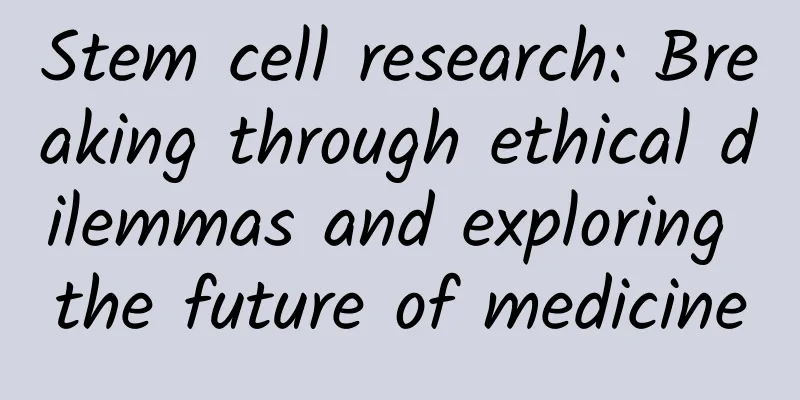Stem cell research: Breaking through ethical dilemmas and exploring the future of medicine

|
A visual representation of the process of SCNT [27] Author: Huang Yanhong Duan Yuechu In an era of rapid development of science and technology, stem cell research, as a cutting-edge exploration in the field of life sciences, is like a shining new star, attracting the attention of researchers around the world. The huge potential it contains and the ethical thinking it triggers have become the focus of heated discussion in the scientific community and the general public. In simple terms, stem cells are a type of cell that has the ability to self-renew and differentiate. According to their sources, they are mainly divided into embryonic stem cells and adult stem cells, of which induced pluripotent stem cells (iPSCs) are a special type of adult stem cells. Embryonic stem cells are derived from early embryos, are pluripotent, and can differentiate into various cell types in the body; while induced pluripotent stem cells are obtained by reprogramming adult somatic cells to give them properties similar to embryonic stem cells. Somatic cell nuclear transfer (SCNT) is an important technical means to obtain embryonic stem cells. Sir Ian Wilmut's team successfully used this technology for the first time when cloning Dolly the sheep. The process is like a precise magic show in the microscopic world: first remove the nucleus of the somatic cell containing the genetic material (DNA) of the organism, then carefully insert this nucleus into the cytoplasm of the enucleated egg cell, and then stimulate the egg containing the nucleus with electric shock to induce mitosis. After multiple mitosis, the cells gradually form blastocysts, which further divide until they finally form embryos. Scientists around the world use SCNT to try to obtain stem cells from cloned embryos for regenerative medicine practices, such as the treatment of Parkinson's disease. By obtaining undifferentiated stem cells from embryos and processing them to differentiate into dopamine-producing nerve cells, it is hoped that the production of dopamine in the brain will be restored, bringing new hope to Parkinson's patients. Induced pluripotent stem cells (iPSCs) are derived from adult somatic cells (usually taken from the patient's bone marrow) and reprogrammed. By introducing specific genes and other factors into the cells, these cells undergo magical changes and become pluripotent. iPSCs not only have unlimited application potential in the fields of regenerative medicine, disease modeling and gene therapy, but also avoid the complex ethical controversies in embryonic stem cell research to a certain extent because they do not require the destruction of embryos. The results of stem cell research have broad and far-reaching application prospects in the medical field. In regenerative medicine, stem cells can be used to repair damaged cells and tissues. Imagine that myocardial cells damaged by myocardial infarction may be reborn through the differentiation and repair function of stem cells; patients who have lost their ability to move due to spinal cord injuries may be able to stand up again and embrace life with the help of stem cell therapy. In terms of disease treatment, stem cell therapy provides new treatment ideas for many difficult diseases. In addition to Parkinson's disease mentioned above, stem cells have shown great therapeutic potential for diseases such as diabetes, blindness, and neurodegeneration. For example, in the treatment of diabetes, it may be possible to differentiate pancreatic islet cells from stem cells, thereby restoring the patient's own ability to regulate blood sugar; for blind patients, retinal cells cultured from stem cells are expected to help them see again. However, stem cell research is not always smooth sailing, and ethical issues are always there. In embryonic stem cell research, the process of obtaining stem cells will inevitably destroy the blastocyst. Although the blastocyst is in the early stage of fetal formation and the cells have not yet differentiated, there are different opinions on whether it should be regarded as a life. Some people believe that the destruction of the embryo is equivalent to killing a fully developed person. For example, Senator Sam Brownback regards "human embryos" as people like you and me. This ethical controversy has led to many obstacles in the process of obtaining funding and legalization of stem cell research. Even in countries that are relatively advanced in stem cell research, there are strict restrictions on the use of embryos. Although induced pluripotent stem cells avoid the ethical issues of destroying embryos, they are not perfect. The main problem is that retroviruses are required during the formation process, and retroviruses may insert their DNA into any location in the human genome, triggering oncogene expression when transplanted into patients, increasing the risk of cancer. In addition, the success rate of reprogramming somatic cells into iPSCs is low, about 0.1%, and iPSCs also have the problem of not always differentiating, which greatly reduces their reliability and practicality. Stem cell research is like a difficult journey between ethics and science, but as long as we have firm beliefs and courage to explore, we will be able to overcome difficulties and let this research result bring more benefits to human health and open a new chapter in the development of medicine. Reference: Navigating Bioethical Waters: The ethical landscape behind stem cell research | Young Scientists Journal |
>>: Can massage promote lactation?
Recommend
Does my child need to see a dentist before all his teeth have grown?
Truth: This is a common misconception. Analysis: ...
How to tighten private parts after childbirth?
In order to make the baby born with stronger resi...
Can I have a baby if I have little menstrual flow?
There are many reasons for scanty menstruation, w...
Are there "indigenous people" in the intestines? Not only that, but if they become a mess, it can be very troublesome!
In our daily life The intestinal flora is often m...
Is it necessary to wear a sports bra when exercising? What will happen if you don't?
Every girl faces the same problem when exercising...
What are the ways to relieve breast pain?
There are many reasons for breastfeeding mothers ...
4 weeks pregnant lower abdomen pain like period pain
Pregnant women's physiological needs, some di...
World Parkson's Day | Parkinson's patients should be aware of these swallowing problems!
Parkinson's disease is a common neurodegenera...
When love can be interfered with by drugs
Leviathan Press: Hormones make you fall in love w...
Can I take L-carnitine during my period?
Women are at their weakest during their menstrual...
Will I get pregnant if my period comes?
Pregnancy is a result of the combination of male ...
7 most worthwhile self-paid vaccines to protect your cute baby’s health!
Parents, please take your human cubs to get vacci...
Can girls eat hawthorn during menstruation?
Hawthorn fruit is rich in pectin, which is a good...
How to check for uterine cold
Uterine coldness is very harmful to women. Dysmen...
What to do if your breasts sag at the age of 20
Some girls begin to experience slight sagging in ...









